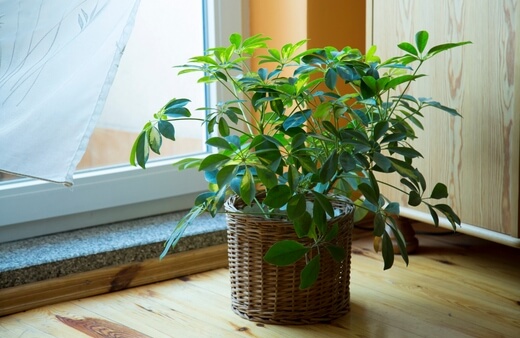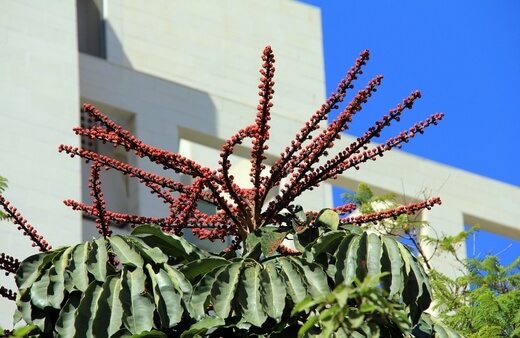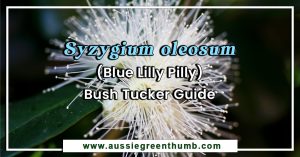The Umbrella Tree, otherwise known as Schefflera, is a gorgeous group of flowering trees, shrubs, and climbers native to Australia, the Pacific Islands and China. While its botanical heritage is hard to pin down, it is well worth getting to grips with to better understand this stunning garden plant.
Whether you plan to grow these native plants indoors or out will have a big impact on how you plant, care for, and position your umbrella tree, so follow the guide below for detailed instructions on Schefflera planting and care.
More...

Family: | Araliaceae |
|---|---|
Genus: | Schefflera |
Species: | various |
Common Names: | Umbrella tree, Dwarf umbrella tree |
Location: | Outdoor or indoor |
Type: | Flowering shrub, tree or climber |
Growth: | 2-3m tall indoors, 15m outdoors |
Sun requirements: | Bright, indirect light |
Foliage Colour: | Green or variegated |
Flower Colour: | Yellow, orange or red |
Flowering: | Spring and summer (all year round in some climates) |
Fruit: | None |
Maintenance level: | Low |
Poisonous for pets: | Toxic to cats and dogs |
What is an Umbrella Tree?
The dwarf umbrella tree, or umbrella tree, is the general name given to a whole range of plants in the Schefflera genus, and can also refer to Heptapleurum arboricola, though the scientific backing for that is contested and the umbrella tree has regularly shifted between each genus in botanical culture for decades.
Regardless of its formal heritage, its properties include reliable summer flowering when grown outdoors, producing dramatic plumes of frothy red, yellow and orange foliage that burst out from the stem beneath outer leaves.
The feature that gave these trees their name though is the distinct umbrella-shaped foliage, with exaggerated palmate leaves.

Natural Habitat of Schefflera
Umbrella trees are native to Australia, the Pacific Islands, Taiwan, and parts of China. They thrive in tropical and subtropical conditions with some shade from taller trees, or even houses, where their roots are able to sit in fairly moist soil, but compete with larger trees for water.
That gives a good clue to how to water but isn’t quite the whole story. In essence, they do not need good drainage, but they also do not like damp soil. That means choosing a reasonably moisture-retentive compost and siting them somewhere warm where they will compete for moisture, or are able to dry out from the sun between waterings.
Personally, I find that positioning for competition produces stronger plants and healthier roots.
How to Grow Umbrella Trees
You can grow these native plants indoors as well as out, but if you want flowers, aim for bright, but indirect light, outdoors, on moist but not sodden soil. Indoor umbrella trees rarely flower, even when grown in their native habitat, due to less changeable temperatures, and regulated watering which mitigates the seasonal change that they need.
Growing Umbrella Trees Outdoors
Umbrella trees, particularly native varieties like Schefflera actinophylla, grow best outdoors in warmer parts of the country. However, if you can protect them from frost, they will grow outdoors anywhere in the world.

Soil & Drainage
Find a spot that is generally well-drained, but not fast-draining, where the roots can benefit from some groundwater, without sitting in boggy conditions. On clay soils, that will mean improving the soil with sand or grit, or planting in raised beds.
On sandy soil, that means digging through plenty of organic compost.
Light
Schefflera are tropical plants but that doesn’t necessarily mean they like full sun. In fact, they prefer to be in bright light but with dappled shade from taller trees – particularly climbing vine varieties.
Water
Schefflera should not be allowed to dry out completely and will lose leaves over prolonged droughts. The plants will largely recover after droughts but will look bare and weak during drought if not watered.
Aim to water them when the surface layer of soil is dry to touch, but there is still some moisture 3cm deep.
How to Grow Umbrella Trees Indoors
Growing umbrella trees indoors is fairly sensible in some parts of Australia as they can spread and self-seed in native soils very readily. They also help to provide shade from low evening light when placed in a western window. These conditions are ideal as they benefit from bright light without ever being in the direct afternoon sun.
The only downside of growing umbrella trees indoors is they are very unlikely to flower, and when they do it won’t be nearly as dramatic as outdoor schefflera.
Soil & Compost
Schefflera don’t like their roots to be teased, so if you can avoid it, do. Fill a pot that is 2-3” wider than the root ball of your umbrella tree with organic peat-free compost up to halfway. Drop your plant into the soil, to the top of its root ball sits about 3 cm below the rim of the pot.
Fill in around the root ball with more compost until it is level with the surface and gently tamp the pot against the floor to fill any air pockets. If necessary, add more compost so the soil is level with the root ball.
Water well, and leave it to dry out on the surface before watering again.
Water Requirements
As with outdoor umbrella trees, indoor plants should be kept reasonably moist, particularly if they are in a very bright warm room. In good conditions (bright but indirect light) they will typically need watering every two weeks.
Light
Umbrella trees like shade, but they need warm spaces to thrive and are not at all frost tolerant, so position your indoor umbrella trees in a bright, warm room, ideally with some morning or afternoon sunlight. About 4 hours of direct low light is ideal.
Propagating Umbrella Trees
Umbrella trees can be propagated in three ways, but by far the best option is cuttings, which will root quickly in clean water, and produce new plants in a matter of days. Slower but less invasive methods include air layering, or ground layering (outdoor only) and growing from seed.

Umbrella Tree Propagation from Cuttings
Umbrella tree cuttings take very well in water, and while they will benefit from rooting hormone, they do not actually need it.
Simply take a cutting of fresh growth in spring or summer by slicing through a node with a clean knife. Then drop that in a glass of clean water, and wait for three to seven days for signs of roots.
Technically that’s a new plant already, but it's worth keeping it in that container for about a month until it has really strong root growth, changing the water every 3-4 days to avoid bacteria building up.
When the roots are growing strongly and there are signs of new growth, carefully place the cutting into a pot of compost, and very gently shake the compost around the roots. Do not cut in, let water and gravity do the work for you.
A few weeks later, roots will have filled the pot and you can treat it like any other umbrella tree.
Propagating Umbrella Trees from Layering
For outdoor umbrella trees, propagation couldn’t be simpler.
- Just bend a young flexible stalk down to ground level, being careful not to snap it.
- Use a tent peg to secure a leaf junction to the soil, and scrape a small piece of the stem’s outer skin at the node.
- Cover with soil and leave it to the elements.
- This time next year there should be a young plant growing strongly, which you can sever from its parent and pot on to plant elsewhere.
Layering is slightly more complex for indoor umbrella trees but much less invasive. All you need is a plastic bag, some tissue paper or moss, and a mister:
- On a stem from this year’s growth, wrap a piece of tissue, banana skin, or sterile moss around a node after removing the leaf.
- Secure that in place with twine, and cover it with cellophane or a plastic bag.
- Keep the contents of the plastic wrap moist for a few weeks, checking regularly for roots.
- When roots are growing strongly, cut below the tissue or moss wrap, and plant into clean compost.
How to Progate Umbrella Trees from Seeds
Umbrella tree seeds, especially when collected from outdoor plants, will rarely grow to mirror their parents, so cuttings are advised for accurate duplication.
If you do find good quality umbrella tree seeds online, propagation is simple but slow:
- Fill a seed tray with seed or cutting compost
- Soak your seeds in warm water overnight
- Carefully push each seed into the compost to a depth of 0.5 - 1 cm
- Water the surface of the soil daily, or when it dries out
- Store in bright light at around 25°C
- Germination can take up to three months, so be patient!
Caring for Umbrella Trees
Mature umbrella plants don’t need mulch, or fertiliser to thrive, and only need pruning when they are showing signs of disease or infection. Following the guide to planting above will remove the need for any mulch, feed, or pruning unless they become waterlogged, overly humid, or scorched by the sun.
If you do need to prune a stem back, cut it back hard, removing any diseased growth, so the stem can regenerate from a healthy point.

Possible Schefflera Pests and Diseases
Umbrella trees are resilient against natural pests outdoors, and will only suffer from fungal or bacterial infection as a result of excessive summer sun, or excessive moisture.
Indoors, schefflera do suffer from aphids, mites, and mealybugs, as well as scales and thrips, which can quickly take over new shoots and prevent leaves from opening. If you ever notice fallen leaves, check around the stem for signs of insect damage and scrape off anything you find.
If the problem persists, use neem oil to spray indoor plants, which will kill most common houseplant pests instantly.
Umbrella Tree Frequently Asked Questions
How do you keep indoor umbrella trees looking good?
Umbrella trees, like many waxy-leaved plants, are very good at attracting dust. That has its benefits for the rest of the room, but it does mean you need to regularly dust and wipe down their leaves to prevent their pores from clogging.
How long do schefflera plants live?
Outdoor schefflera plants can live for many years, thriving in their native habitat. Indoors, schefflera tend to have a lifespan of about 30 years, which can be extended by planting them in the garden or larger containers so their roots don’t suffer from excessive restriction.
Why is my umbrella tree turning brown and dropping leaves?
Umbrella trees that are dropping leaves and turning brown are either suffering from overwatering, underwatering, or extremely low humidity. If your umbrella tree has moist soil and is still exhibiting these symptoms, re-pot it into a better-drained mix, removing any damaged roots as you go. If the soil is dry, increase humidity but maintain your watering schedule.
How do I get my schefflera to bloom?
Schefflera do tend to struggle with blooming indoors, but to encourage them you can boost their light levels slightly for a few months each year. Still avoid full sun, but aim to provide a summer change so that they understand the seasons.
When should I repot my umbrella tree?
Umbrella trees will need repotting every three years. Fresh compost will give them a gentle nutrient boost without shocking them, and the extra space will trigger fresh new growth, potentially triggering flowering the following summer.
Do umbrella trees need misting?
Umbrella trees need some humidity, but not too much. In their native space, they benefit from natural humidity paired with good ventilation, so a room humidifier is a better option than directly misting foliage.
Refer to our in-depth plant humidifier buying guide and product reviews to help you choose the right humidifier for your home.
Can schefflera live outside in winter?
The only real winter requirement of schefflera is that they do not freeze, so if you live in an area where frost is likely, bring them indoors from winter. For most of Australia, the temperatures rarely drop to a point that will damage umbrella trees for long enough to affect them, so they can usually stay outside all year round.
Wrapping Up Our Umbrella Tree Guide
Umbrella trees might have a complicated history when it comes to classification, but let's face it, that shouldn’t bother us as gardeners. These dramatic trees, shrubs, and climbing plants work wonders for garden designers, providing native interest in urban gardens.
If you decide against planting these slightly thuggish plants in the garden, remember that it's more than possible to grow them happily indoors for many years, where you will get just as much benefit from their impactful foliage.
Published on March 13, 2023 by Lorri Hopkins
Last Updated on February 23, 2024




